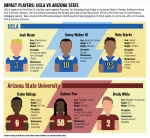UCLA heads to Tempe, Arizona, this weekend for its annual matchup with Pac-12 South rival Arizona State. Last year, the Sun Devils got the better of the Bruins, pulling off the 38-23 upset at the Rose Bowl on Oct. 3, 2015.
This year, the circumstances leading up to the game are exactly the same: UCLA (3-2, 1-1 Pac-12) is coming off a blowout win over Arizona, and Arizona State (4-1, 1-1) is coming off a blowout loss to USC. The Bruins are once again considered the favorite by all of the major betting sites, with the point spread hovering between 9.5 and 10 points.
Without further ado, here is a scouting report for Arizona State, a team that deploys a run-first offense and a traditionally blitz-heavy defense.
Arizona State’s offense
Base formations: Spread, pistol
Run-pass percentage: 58.7 percent run, 41.3 percent pass
Strength: Running backs
Weakness: Quarterback and downfield passing
X-factor: RB Kalen Ballage
The Bruins have already faced two of the nation’s best running backs – BYU’s Jamaal Williams and Stanford’s Christian McCaffrey – and now they will face one of the nation’s best running back duos in Kalen Ballage and Demario Richard. Both backs are built around their power, weighing in at about 220 pounds apiece, but Ballage is much more imposing, standing at 6 feet 3 inches.
Many Pac-12 fans are very familiar with Ballage. Once a three-star athlete recruit coming out of Peyton, Colorado, Ballage passed on scholarship offers from six Pac-12 schools – including UCLA – to play for Todd Graham’s squad in Tempe.
Ballage has epitomized the “boom-or-bust” notion during his two-plus years at Arizona State. There have been certain games – such as his eight-touchdown game against Texas Tech earlier this year – where he has broken out and dominated defenses. On the other hand, there have been other games – such as his six-carry, nine-yard performance against USC last week – where Ballage has looked pedestrian.
The Bruins appear to be better-equipped to face a power back like Ballage this year, with their more physical 4-3 defensive front. Last year, when UCLA ran the 3-4 defense, sturdy tailbacks like Ballage and Richard had their way with the Bruins. That hasn’t been the case this year, as UCLA has emerged as one of the best run defenses in the country.
Standing next to Ballage and Richard in the backfield will be a highly inexperienced – yet fairly hyped – quarterback in Brady White.
White was the No. 4-ranked pocket passer in the 2015 high school recruiting class – just two spots behind current UCLA sophomore quarterback Josh Rosen. He lost the battle for the starting QB job this offseason to redshirt sophomore Manny Wilkins, but was forced into the starting role last week when Wilkins went down with a foot injury.
With Wilkins being listed as doubtful for Saturday, it is likely that White will get his first career start.
If White starts at quarterback, it will be a huge advantage for the UCLA defense. So far this year, one of the Bruins’ main weaknesses has been defending scrambling quarterbacks, and White doesn’t present a legitimate ability to scramble. Wilkins, on the other hand, is very quick out of the backfield and presents scrambling ability on every snap. The Sun Devils’ read-option play works effectively with Wilkins, but it won’t be nearly as deceptive with the slower White on the field.
Overall, expect Arizona State to run the ball frequently and throw an array of short passes to take the pressure off of White in his first start. The Sun Devils have a propensity for bubble screens and short routes, so the UCLA cornerbacks will need to play tight in coverage.
Arizona State’s defense
Base defense: 3-3-5
Blitz tendency: High
Strength: Run defense
Weakness: Pass defense
X-factor: CB Gump Hayes
Arizona State’s pass defense has been its kryptonite over the past year now. Last season, the Sun Devils finished dead last in pass yards allowed per game, and this year, they’re 107th in pass efficiency defense.
Many of Arizona State’s struggles in pass defense can be attributed to their blitz frequency. According to Pro Football Focus, the Sun Devils blitzed on 49 percent of their plays last year, which was the third-highest blitz rate in the country.
This year, Graham has dialed it down a notch with the blitzes, but the results are still the same: Arizona State is giving up big plays in bunches. Through five games, the Sun Devils rank 99th in the NCAA in IsoPPP+, a metric used to measure explosive plays.
It comes as no surprise that Arizona State is struggling in pass defense, considering that one of its starting cornerbacks – redshirt senior Gump Hayes – is in his first season playing the position. The cornerback opposite Hayes – Kareem Orr – is also relatively inexperienced, as he’s in just his second collegiate season.
Facing a standout quarterback like Rosen, Arizona State will likely play loose coverage to prevent deep passes. As a result, the Bruins have to be ready to settle for the intermediate routes – something that Rosen has neglected to do at some points this season.
